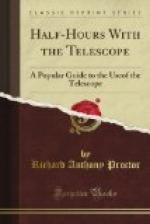A star of the first magnitude should next be brought into the field of view. If an irradiation from one side is perceived, part of the object-glass has not the same refractive power as the rest; and the part which is defective can be determined by applying in different positions a cap which hides half the object-glass. If the irradiation is double, it will probably be found that the object-glass has been too tightly screwed, and the defect will disappear when the glass is freed from such undue pressure.
If the object-glass is not quite at right angles to the axis of the tube, or if the eye-tube is at all inclined, a like irradiation will appear when a bright star is in the field. The former defect is not easily detected or remedied; nor is it commonly met with in the work of a careful optician. The latter defect may be detected by cutting out three circular cards of suitable size with a small aperture at the centre of each, and inserting one at each end of the eye-tube, and one over the object-glass. If the tube is rightly placed the apertures will of course lie in a right line, so that it will be possible to look through all three at once. If not, it will be easy to determine towards what part of the object-glass the eye-tube is directed, and to correct the position of the tube accordingly.
The best tests for determining the defining power of a telescope are close double or multiple stars, the components of which are not very unequal. The illuminating power should be tested by directing the telescope towards double or multiple stars having one or more minute components. Many of the nebulae serve as tests both for illumination and defining power. As we proceed we shall meet with proper objects for testing different telescopes. For the present, let the following list suffice. It is selected from Admiral Smyth’s tests, obtained by diminishing the aperture of a 6-in. telescope having a focal length of 8-1/2 feet:
A two-inch aperture, with powers of from 60 to 100, should exhibit
[alpha] Piscium (3".5). | [delta] Cassiopeiae (9".5), | mag. (4 and 7-1/2) [gamma] Leonis (3".2). | Polaris (18".6), mag. (2-1/2 | and 9-1/2)
A four-inch, powers 80 to 120, should exhibit
[xi] Ursae Majoris (2".4). | [sigma] Cassiopeiae (3".1), | mag. (6 and 8). [gamma] Ceti (2".6). | [delta] Geminorum (7".1), | mag. (4 and 9).
The tests in the first column are for definition, those in the second for illumination. It will be noticed that, though in the case of Polaris the smaller aperture may be expected to show the small star of less than the 9th magnitude, a larger aperture is required to show the 8th magnitude component of [sigma] Cassiopeiae, on account of the greater closeness of this double.
In favourable weather the following is a good general test of the performance of a telescope:—A star of the 3rd or 4th magnitude at a considerable elevation above the horizon should exhibit a small well defined disc, surrounded by two or three fine rings of light.




